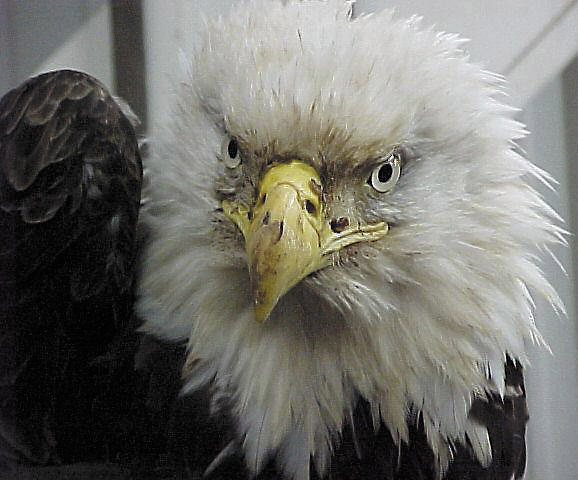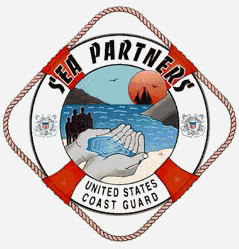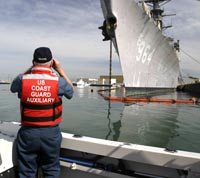Marine Safety – Environmental and Homeland Protection

TWO IMPORTANT MISSIONS – FOR ALL OF US!
Protecting our environment, and contributing to keeping our homeland safe, are everyone’s responsibility. In the marine domain, the United States Coast Guard has been mandated by Congress to be in charge of these two important missions – both on the prevention side, and on the response. But they can’t do it alone.
On the prevention side, the Coast Guard, with the assistance of the Auxiliary, has established outreach missions in each of these areas, designed to inform you, the general public, how you can make a sensitivity to threats to the marine environment – both environmental and tactical – part of your everyday awareness.
 Environmental Outreach
Environmental Outreach
Our joint environmental outreach mission is called Sea Partners, and it is principally an education program, that we cannot do full justice to here. It is supported by a substantial Website of its own, maintained by the Coast Guard.
The Auxiliary supports Sea Partners and environmental outreach through its formal public education courses, public awareness booths at tradeshows, literature distribution through our Visitation Program, and even visits to elementary schools as part of teaching our children about boating safety.
If you have further interest in this important topic, please see “Environment Protection” in the extensive “Marine Safety Links” to the left.
New Oil and Fuel Pollution Prevention Boating Videos
California’s Boating Clean and Green Program provides tips on proper oil and fuel management to the state’s recreational boating community through two new instructional videos.
Videos include tips and tools to prevent oil and fuel discharges; how to report oil and chemical spills; how to properly dispose of used oil; environmental laws; and information on other clean and safe boating practices recommended for before, during and after fueling boats.
The educational videos are a great resource not only to boaters, but to boating marina and yacht club operators in their efforts of keeping their facilities clean. Please share these valuable resources by posting the videos on your websites. Videos may be viewed and downloaded at www.BoatingCleanAndGreen.com. (look for DBW TV on that page). Or view these videos on YouTube.
Oil Pollution Prevention: http://www.youtube.com/watch?v=xNwKSOXCBbY
Fuel Pollution Prevention: http://www.youtube.com/watch?v=V5Jx8m9hY3g
The Division of Boating and Waterways and the California Coastal Commission’s Boating Clean and Green Program developed the videos in partnership with theSan Francisco Estuary Partnership, the Keep the Delta Clean Program, and the Santa Monica Bay Restoration Foundation. Staff developed the video content with assistance, review, and support from a Technical Advisory Group comprised of members with the marine industry and boating associations (listed in the video credits).
The videos were shot in October 2012 in Sacramento (Riverbank Marina) and in Oakland (Oakland Yacht Club and Marina Village Yacht Harbor). During the fuel video shot, staff worked with Captain Tommy Holtzman (Boat Owner and US Coast Guard Auxiliary), his boat the “Shady Ladies” and his crew (John Derrick Jr. and Warren Golubski (Boaters and US Coast Guard Auxiliary) and Chloe Golubski, an adorable dog. In the oil clean boating video, staff worked with Captains Robert J. & Susan Engelhart and their boat “Music.”
The Boating Clean and Green Program is an education and outreach program conducted through the Division of Boating and Waterways and California Coastal Commission. The program promotes environmentally-sound boating practices to marine businesses and boaters.
 Marine Domain Awareness
Marine Domain Awareness
Since the events of September 11, 2001, we have all adopted a heightened sense of security for the protection of our homeland, particularly our critical ports and waterways. The Coast Guard’s appointed mission is called Marine Domain Awareness, and they have enlisted your help.
In a fashion similar to the citizen Coast Watchers during World War II, the public today is being asked to share in that increased awareness, by participating in “America’s Waterway Watch”, an informal program of increased vigilance. With over 92,000 miles of coastline to protect, and thousands of points of entry, the mission is simply too large for the Coast Guard; it’s got to be all of ours.
For more information about America’s Waterway Watch, what to look for, and how to respond, please visit “America’s Waterway Watch”, to the left, as well as the extensive AWW website referenced in the links.
